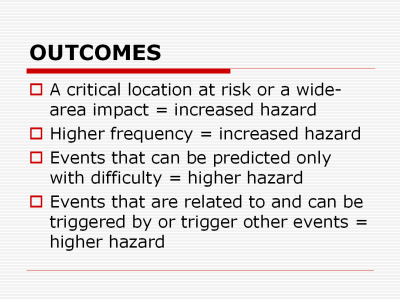| front |1 |2 |3 |4 |5 |6 |7 |8 |9 |10 |11 |12 |13 |14 |15 |16 |17 |18 |19 |20 |21 |22 |23 |24 |review |
 |
The
wider the area the disaster impacts
may cover, the greater the hazard the event poses.
The presence of critical facilities in the probable
impact zone increases the hazard.
This includes facilities necessary for the coordination of disaster
response or the operation of emergency government.
The more often events happen the greater the hazard because of cumulative effects. This is not universally so; in some cases relatively minor events may release energy that could lead to catastrophic failures. Events that are difficult to predict create a higher hazard because of the lack of reliable signals that protective measures are necessary. For example, earthquake prediction is currently a very uncertain activity; as a result evacuation and other protective actions are difficult to implement. However, volcanic eruption prediction is becoming reasonably accurate, with evacuation now being a very successful protective tactic (early examples of this being the Mount Saint Helens and the Mount Pinatubo evacuations).Finally events that trigger other events or that cause cascading effects are higher in their hazard potential than events that do not typically do so. The combination of earthquakes and tsunamis is a clear example. In an event such as the Good Friday Alaska Earthquake, a large quake causes extensive damage, followed by a tsunami that damages coast lines even at some distance from the quake epicenter. |